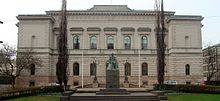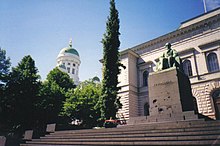Bank of Finland
 | |
| Headquarters | Helsinki |
|---|---|
| Established | 1 March 1812 |
| Ownership | 100% state ownership[1] |
| Governor | Olli Rehn |
| Central bank of | Finland |
| Reserves | 6 230 million USD[1] |
| Succeeded by | European Central Bank (1999)1 |
| Website | www.bof.fi |
| 1 The Bank of Finland still exists but many functions have been taken over by the ECB. | |
The Bank of Finland (Finnish: Suomen Pankki, Swedish: Finlands Bank) is the Finnish member of the Eurosystem and has been the monetary authority for Finland from 1812 to 1998, issuing the markka since 1860. It views itself as the fourth oldest surviving central bank in the world, after Sweden's Riksbank, the Bank of England, and the Bank of France.[2] Unlike the latter two and many other longstanding central banks, it has always been government-owned.
History
[edit]



Russian Empire
[edit]In 1809, the Russian Empire annexed Finland and made it a Grand Duchy with its own administrative structure. One aim of the new authorities was to sever Finland's previous economic integration with Sweden, including the use of the Swedish riksdaler as currency. To that effect, the Exchange, Loan and Deposit Office of the Grand Duchy of Finland (Finnish: Waihetus-, Laina- ja Depositioni-Contori Suomen Suuren-ruhtinaanmaassa) was chartered on 12 December 1811 and established on 1 March 1812 in Turku by Alexander I of Russia, partly modeled on the Bank of Sweden.[3][4] It issued banknotes denominated in rubles and kopecks and provided credit to local landowners and merchants.[5]
In 1819 the institution relocated to Helsinki. Its efforts to displace the Swedish currency were only partly successful, however, until 1840 when the remaining riksdaler banknotes were forcibly withdrawn from circulation. That same year, the institution was formally renamed Bank of Finland, and opened its first branches in Turku and Vaasa. From then on, its Russian currency-denominated notes became the dominant means of payment in the Grand Duchy. Consequently, Finland suffered from the Russian monetary disorder in the wake of the disastrous Crimean War in the late 1850s, when the ruble was de-anchored from the silver standard.[5]
Requests for greater protection from Russian monetary vagaries were addressed in 1860, the same year as the State Bank of the Russian Empire was established, when the Bank of Finland was authorized to issue its own denomination, the Finnish markka, defined as a quarter of the Russian paper ruble. In 1865, a major step towards monetary autonomy was achieved as Finnish Senator Johan Vilhelm Snellman obtained from Alexander II the right to keep the markka linked to the silver standard irrespective of the ruble's situation. From then on, the Bank of Finland effectively set its own monetary policy, making the Grand Duchy a separate currency zone from the rest of the Russian Empire, even though this only became evident when Russia again debased the ruble during the Russo-Turkish War (1877–1878).[5]
In 1868, the ownership and oversight of the Bank was transferred from Finland's executive Senate to its legislative Diet (from 1906, the Parliament of Finland), thus strengthening its independence and accountability along the lines adopted by Sweden. In 1878, the Bank of Finland shifted from silver to the gold standard by unilaterally joining the Latin Monetary Union, a stance it kept until the outbreak of World War I.[5]
Independent Finland
[edit]Following the independence of Finland in 1917, the Bank of Finland initially faced civil war turmoil and high inflation but managed to stabilize the markka in 1923, at about ten percent of its prewar gold value. It returned to the gold standard in 1926, but floated again in the wake the European banking crisis of 1931. In the spring of 1933, it pegged the markka to the pound sterling. During the interwar period, the Bank acquired great prestige in the new country, linked to the leadership of its longstanding governor Risto Ryti who became Prime Minister of Finland in December 1939 and President a year later in the midst of the Interim Peace. After World War II and a renewed inflationary episode until the early 1950s, the Bank of Finland managed the country's regime of financial repression, then liberalization in the 1980s. The markka was devalued on multiple occasions until finally floating in September 1992.[5]
New practices and technologies led the Bank of Finland to phase out its local branch network, starting with closing the Hämeenlinna branch in 1963. In the years 1991–1994, eight other branches were closed, leaving only Turku, Tampere, Kuopio, Oulu and Vantaa in operation. The Turku branch was closed in 2007, those in Tampere and Kuopio in 2012, and the Oulu branch in 2019.
Following the 1990s Finnish banking crisis, financial supervision was reorganized in Finland with the creation of the Rahoitustarkastus (Rata) in 1993, an independent banking supervisor which is part of the Bank of Finland albeit with its own separate governance. In 2009, the Finnish Financial Supervisory Authority was formed by merging Rata with the previously separate insurance supervisor.
At the start of Economic and Monetary Union, Bank of Finland Governor Sirkka Hämäläinen joined the inaugural Executive Board of the European Central Bank on 1 June 1998, becoming its first female member.[5]
Mandate, ownership and organization
[edit]The Bank of Finland is Finland's central bank and a member of the European System of Central Banks and of the Eurosystem.[6] It is Finland's monetary authority, and is responsible for the country's currency supply and foreign exchange reserves.
The Bank of Finland is owned by the Republic of Finland, and governed by the Finnish Parliament through the Parliamentary Supervisory Council and the Board of the bank. The Board is responsible for the administration of the bank, and the Parliamentary Supervisory Council for supervising the administration and activities of the bank and for other statutory tasks. The bank is governed under the provisions of the Act on the Bank of Finland, passed in 1998.
The bank had a staff of about 380 persons in 2017.[7]
The highest official in the bank is the Governor who also chairs the board. Members of the Board in August 2018[update] were Olli Rehn (Governor), Marja Nykänen (Deputy Governor) and Tuomas Välimäki.[7]
BOFIT
[edit]BOFIT is an internal think tank of the Bank of Finland, which has historically been driven by the imperative for Finland to gain a granular understanding of the economic situation of Russia. It was created in 1991 and drives its name from the Finnish name of the department from which it originated, namely BOF for Bank of Finland and IT for idäntutkimus or research in bilateral [Finnish-Russian] trade. The full name has changed over the years, until 2021 as "Bank of Finland Institute for Economies in Transition" and since November 2021 as "Bank of Finland Institute for Emerging Economies".[8] Since 2009, BOFIT has been led by Iikka Korhonen, who joined it in 1995.
Governors of the Bank of Finland
[edit]- Claes Johan Sacklén 1812–1816
- Carl Johan Idman 1817–1820
- Otto Herman Lode 1820–1827
- Johan Gustaf Winter 1827–1841
- Carl Wilhelm Trapp 1841–1853
- Axel Ludvig Born 1853–1856
- Alex Federley 1853–1854
- Robert Trapp 1854–1856
- Frans Ivar Edelheim 1856–1858
- Wilhelm Blidberg 1858–1861
- Carl Isak Björkman 1862–1866
- Victor von Haartman 1866–1870
- August Florin 1870–1875
- Gustaf Samuel von Troil 1875–1884
- Alfred Charpentier 1884–1897
- Theodor Wegelius 1898–1906
- Clas Herman von Collan 1907–1918
- Otto Stenroth 1918–1923
- August Ramsay 1923–1924
- Risto Ryti 1923–1940
- Johan Wilhelm Rangell 1943–1944
- Risto Ryti 1944–1945
- Sakari Tuomioja 1945–1955
- Rainer von Fieandt 1955–1957
- Klaus Waris 1957–1967
- Mauno Koivisto 1968–1982
- Ahti Karjalainen 1982–1983
- Rolf Kullberg 1983–1992
- Sirkka Hämäläinen 1992–1998
- Matti Vanhala 1998–2004 (retired early due to illness)
- Erkki Liikanen 2004–2018
- Olli Rehn 2018–[9]
Chairmen of the Parliamentary Supervisory Council
[edit]- Erik von Frenckell
- Juho Niukkanen
- Veikko Kokkola
- Juha Rihtniemi (−1971)
- Harri Holkeri (1971–1979)
- Matti Jaatinen (1979–1987)
- Mauri Miettinen (1987–1990)
- Erkki Pystynen (1990–1991)
- Pentti Mäki-Hakola (1991–1995)
- Sauli Niinistö (1995)
- Ilkka Kanerva (1995–2003)
- Mauri Pekkarinen (2003)
- Olavi Ala-Nissilä (2003–2006)
- Mari Kiviniemi (2006–2007)
- Seppo Kääriäinen (2007–2008)
- Timo Kalli (2008–2011)
- Ben Zyskowicz (2011–2015)
- Matti Vanhanen (2015–2019)
- Antti Lindtman (2019–present)
See also
[edit]References
[edit]- ^ a b Weidner, Jan (2017). "The Organisation and Structure of Central Banks" (PDF). Katalog der Deutschen Nationalbibliothek.
- ^ "History". Bank of Finland. Archived from the original on 28 October 2014. Retrieved 28 October 2014.
- ^ Holtfrerich, Carl-L.; Reis, Jaime (5 December 2016). The Emergence of Modern Central Banking from 1918 to the Present. Routledge. ISBN 9781351890779 – via Google Books.
- ^ "Wäxel- Låne och Depositions-Contoiret i Stor-Furstendömet Finland" [Exchange, Loan and Deposit Office in the Grand Duchy of Finland]. histdoc.net (in Swedish). Archived from the original on 13 September 2017. – Imperial ordinance by Alexander I of Russia, 20 November 1811 (in Russian)
- ^ a b c d e f Seppo Honkapohja (23 October 2014), Bank of Finland's 200 years
- ^ "Eurosystem and ESCB". Bank of Finland. Retrieved 24 March 2023.
- ^ a b "Organisaatio" [Organization]. Bank of Finland (in Finnish). Retrieved 14 April 2017.
- ^ Olli Rehn (9 November 2021). "Remarks - Bank of Finland Institute for Emerging Economies' (BOFIT) 30th Anniversary Dinner" (PDF). Bank for International Settlements.
- ^ "Board Members in the history of the Bank of Finland". Bank of Finland. Archived from the original on 7 August 2017. Retrieved 13 April 2017.
External links
[edit]- (in Finnish, Swedish, and English) Bank of Finland official site
- Postage stamp commemorating the 150th anniversary of the Bank of Finland 1811–1961
- All the Finnish BIC-codes and an IBAN counter for all Finnish banks
